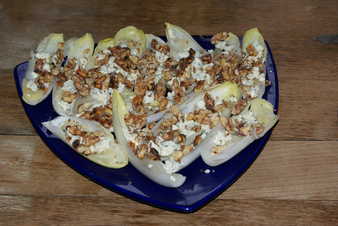
Mustard Meal
A little bit oyster, little bit mustard meal that I made on a little bit of a spur of the moment.
And then had a little bit of a scramble to find people to eat it!
menu
Starter
Herb and Mustard Bread
Strathdon Blue and Walnut Salad
Main Course
Saddle of Lamb Stuffed with Oysters in a Mustard and Port Glaze
Butternut Squash and Mustard Gratin
Braised Green Peas
Mustard Roast Potatoes
Dessert
Liquorice Panna Cotta with Raspberry Syrup
Herb and Mustard Bread
Strathdon Blue and Walnut Salad
Handy filled chicory leaves Hors D'oeuvres.
Main Course
Saddle of Lamb Stuffed with Oysters in a Mustard and Port Glaze
Butternut Squash and Mustard Gratin
Braised Green Peas
Mustard Roast Potatoes
Dessert
Liquorice Panna Cotta with Raspberry Syrup
Strathdon Blue and Walnut Salad
salad starter veg
Chicory leaves filled with Strathdon Blue cheese, pear and walnut.
These little guys are easy to pick up, so they make good hors d'oeuvres
(which though French for starter doesn't really mean a starter) or a cheese course too.
I've just made this a slightly more Scottish version of a Nigel Slater recipe - thanks Nigel.
I've just made this a slightly more Scottish version of a Nigel Slater recipe - thanks Nigel.
Serves 4 as a starter or 8 as an hors d'oeuvres
Ingredients
- 100g walnut halves
- zest 1 lemon
- a little lemon juice
- 1-2 pears
- 100g Strathdon Blue or Stichelton or Stilton
- 16 chicory leaves (1-2 slim heads)
Toast the walnuts in a dry shallow pan.
Grate the lemon zest into a bowl, then add the lemon juice (to flavour and stop the pear discolouring). Using a vegetable peeler, remove thin slices of the pears and drop into the lemon juice. You can either peel the pear first, or work around leaving a thin line of skin on one side of your slices. Discard the first slice though :)
Crumble the cheese into large pieces by scraping it while chilled with a fork or the point of a knife. Separate the leaves of the chicory - you will need 16 medium to small leaves. Place the leaves, closely together, on a board or serving plate. Add pieces of the marinated pear, cheese and toasted walnuts to each one.
Grate the lemon zest into a bowl, then add the lemon juice (to flavour and stop the pear discolouring). Using a vegetable peeler, remove thin slices of the pears and drop into the lemon juice. You can either peel the pear first, or work around leaving a thin line of skin on one side of your slices. Discard the first slice though :)
Crumble the cheese into large pieces by scraping it while chilled with a fork or the point of a knife. Separate the leaves of the chicory - you will need 16 medium to small leaves. Place the leaves, closely together, on a board or serving plate. Add pieces of the marinated pear, cheese and toasted walnuts to each one.
Butternut Squash and Mustard Gratin
side veg
Butternut squash with red onion gratin in mustard cream.
Lots of sweet, mustardy juices here to spoon over the roast pork. - Nigel
Serves 4-6
Ingredients
- 2 medium red onions
- 1kg butternut squash about one large squash or pumpkin, unpeeled weight
- 700ml double cream
- a little milk to thin the cream (optional)
- a grating of nutmeg
- scant 3 tablespoons wholegrain mustard
Set the oven at 160C/gas mark 3.
Peel the onions, then slice them very finely. If you want to avoid mouthfulls of tangled onion skeins make sure they are sliced thinly and perhaps halve or quarter the onions first. It might be a good idea to blanch the onion - take the edge of their slight stringiness. Halve the butternut squash, peel it, scoop out the seeds and stringy stuff, then slice it up across the long axis into about 1mm - as if you were making a potato dauphinoise. Quarter the squash if the halves are very wide.
Layer the onions and butternut slices in a large baking dish, slightly overlapping. Put the cream in a jug or bowl, thinning it down with milk if your cream is very thick, season with salt and pepper, nutmeg and the mustard then pour over the squash and onions.
Bake uncovered for 2 hours or more till tender to the point of a knife - cover lightly with foil if the top starts to get too crisp. The slices should be al dente rather than soft as in a potato gratin. Serve with plenty of the juices from the baking tin.
Peel the onions, then slice them very finely. If you want to avoid mouthfulls of tangled onion skeins make sure they are sliced thinly and perhaps halve or quarter the onions first. It might be a good idea to blanch the onion - take the edge of their slight stringiness. Halve the butternut squash, peel it, scoop out the seeds and stringy stuff, then slice it up across the long axis into about 1mm - as if you were making a potato dauphinoise. Quarter the squash if the halves are very wide.
Layer the onions and butternut slices in a large baking dish, slightly overlapping. Put the cream in a jug or bowl, thinning it down with milk if your cream is very thick, season with salt and pepper, nutmeg and the mustard then pour over the squash and onions.
Bake uncovered for 2 hours or more till tender to the point of a knife - cover lightly with foil if the top starts to get too crisp. The slices should be al dente rather than soft as in a potato gratin. Serve with plenty of the juices from the baking tin.
Very tasty, though it might take longer to cook than you expected!
I had hoped to use a pastry-cutter to bore out nice presentations of the gratin, but it's actually quite sloppy (and the squash quite firm) making that a little tricky.
Incidentally, you can make this with pumpkin rather than butternut squash, but it will have nowhere near as much flavour and taste mostly of onion.
I suppose you could try reducing the onion quantity to compensate?
I had hoped to use a pastry-cutter to bore out nice presentations of the gratin, but it's actually quite sloppy (and the squash quite firm) making that a little tricky.
Incidentally, you can make this with pumpkin rather than butternut squash, but it will have nowhere near as much flavour and taste mostly of onion.
I suppose you could try reducing the onion quantity to compensate?
Saddle of Lamb Stuffed with Oysters in a Mustard and Port Glaze
main meat
According to the recipe pre-blurb, there were clear traditional combinations of fish and meat -
anchovies with beef, oysters with mutton, crab with lamb.
Certainly there are plenty
of eighteenth century recipes for shoulder of mutton with oysters,
though I'm not so sure about the lamb and crab.
Anyway, since you can hardly find mutton these days the recipe calls for a 3lb saddle of lamb. They suggest either using fresh (or frozen oysters), or a combination of smoked oysters and crab-meat. I slightly misread the recipe and bought both fresh oysters and crab-meat, and since I didn't have the quantity of oysters suggested I used a bit of both, plus some anchovies. But I think the crab-meat was pretty unnecessary, and the quantity of oysters excessive so I've adjusted the recipe below.
They say that if you do happen to come across a mutton you should double the amount of stuffing. And the number of guests.
Get your butcher to cut out the bones and trim the saddle so it's nice and tidy, not too fatty and will roll up prettily. If he's as nice a butcher as mine he'll show you how to roll it up, and throw in some butcher's twine for the job too. Though given that he'll be charging you thirty quid for the privilege I guess he can afford to!
Make sure to keep the bones and trimmings for the stock.
Anyway, since you can hardly find mutton these days the recipe calls for a 3lb saddle of lamb. They suggest either using fresh (or frozen oysters), or a combination of smoked oysters and crab-meat. I slightly misread the recipe and bought both fresh oysters and crab-meat, and since I didn't have the quantity of oysters suggested I used a bit of both, plus some anchovies. But I think the crab-meat was pretty unnecessary, and the quantity of oysters excessive so I've adjusted the recipe below.
They say that if you do happen to come across a mutton you should double the amount of stuffing. And the number of guests.
Get your butcher to cut out the bones and trim the saddle so it's nice and tidy, not too fatty and will roll up prettily. If he's as nice a butcher as mine he'll show you how to roll it up, and throw in some butcher's twine for the job too. Though given that he'll be charging you thirty quid for the privilege I guess he can afford to!
Make sure to keep the bones and trimmings for the stock.
Serves 8
Ingredients
- 1 small saddle of lamb, about 1.6 kg/3 lb boned weight, bones and trimmings reserved
- 2 sprigs lemon thyme
- 2 garlic cloves, peeled, sliced fat-ways
- Maldon salt
- freshly ground black pepper
- 2 tablespoons Dijon mustard
- 5 tablespoons port
- 2 tablespoons redcurrant jelly
For the stuffing:- 25g/1oz unsalted butter
- 1 medium onion, finely chopped
- 4-6 anchovies, finely chopped
- 4 oz/120g shucked oysters - about a dozen Or frozen. But defrost them first :)
- or
- 125 g/4 oz can smoked oysters, drained, plus 125g/4oz white crab-meat though you might need less
- 1 bunch watercress, about 100g, leaves only finely chopped
I used 2x100g packets of watercress yielding 70g leaves - which seemed alright - some of the juice of 1 lemon
- I added the grated zest of half the lemon too
- freshly ground allspice I used nutmeg
For the stock:- 1 small onion stuck with 6 cloves
- 1 cinnamon stick though I used cassia - it has a deeper flavour for stock!
- 1 celery stick
- fresh parsley
- 1 bay leaf
- fresh chervil I substituted tarragon
- couple pieces lemon zest perhaps a quarter of the lemon
- 2 tablespoons white wine vinegar
- ½ teaspoon sugar
First, make a light stock with the reserved bones and trimmings, the stock ingredients and 1 litre/1¾ pints cold water.
Bring slowly to the boil, skim off any scum then simmer gently for an hour or so, half-covered.
Strain through layers of muslin, then simmer uncovered for a further 15-20 minutes until reduced to 250ml/½ pint.
Cool, skim off the fat and reserve.
To make the stuffing, melt the butter, add the onions and stew gently for 20 minutes until softened but not coloured. Remove from the heat, stir in the whole oysters, or the smoked oysters and crab-meat, then add the watercress, anchovies, lemon peel, and nutmeg. Add as much lemon juice as necessary to form a thick paste, but not so much as to make it sloppy. Season well and mix thoroughly.
Place the lamb, skin side down, on a flat surface and open it out. Scatter with the thyme leaves and the slices of garlic, then spread the stuffing evenly down both sides. Keep most of the filling away from the edges as some will be squeezed out. Carefully fold up the outer flaps of meat, roll together and tie securely with string - taking a turn lengthways around the joint, then repeatedly looping the log to hold it closed.
Place the joint, with the join in the folded skin down, on a roasting rack. Add a little water (or stock, oyster juice, lemon juice or any other liquid you have about) perhaps a generous tablespoon, herbs too if you like, to the pan to stop any early leaking juices from burning and tainting your jus.
Mix together the mustard and port.
Gently heat the redcurrant jelly until melted - add a tablespoon of water or Chambord! to the pan to prevent burning. Stir into the mustard and port then smear the lamb with some of the sauce. Keep the pan warm.
Cook in the oven at 200°C/400°F/Gas Mark 6 for about 1½ hours for pink lamb (25 minutes per lb) I would say less - check after little more than an hour to just over 2 hours (35 minutes per lb) for well-done meat.
Baste with the remaining mustard and port sauce every 20-30 minutes, and add a little more liquid to the roasting tin if the jus is starting to dry out or burn. Turn down the oven, or loosely cover the joint, if the crust looks worryingly dark or burned.
Remove the joint to a warmed platter to rest 10-20 minutes covered with tin foil. Ideally until the internal temperature cools back down to at most 120°F (49°C). Scrape up the sediments in the roasting tin, pour off any excess fat then add the stock and boil furiously for 3-4 minutes to reduce slightly and heighten the flavours. Pour into a warmed sauce-boat and serve with the lamb cut into thick slices.
Strain through layers of muslin, then simmer uncovered for a further 15-20 minutes until reduced to 250ml/½ pint.
Cool, skim off the fat and reserve.
I added the sugar after I'd strained the stock, but before reducing.
The sugar definitely helps to counteract a slightly bitter edge to the stock, and adds a hint of caramel if you reduce it fairly fiercely and brown around the edges of the pan.
The sugar definitely helps to counteract a slightly bitter edge to the stock, and adds a hint of caramel if you reduce it fairly fiercely and brown around the edges of the pan.
To make the stuffing, melt the butter, add the onions and stew gently for 20 minutes until softened but not coloured. Remove from the heat, stir in the whole oysters, or the smoked oysters and crab-meat, then add the watercress, anchovies, lemon peel, and nutmeg. Add as much lemon juice as necessary to form a thick paste, but not so much as to make it sloppy. Season well and mix thoroughly.
Place the lamb, skin side down, on a flat surface and open it out. Scatter with the thyme leaves and the slices of garlic, then spread the stuffing evenly down both sides. Keep most of the filling away from the edges as some will be squeezed out. Carefully fold up the outer flaps of meat, roll together and tie securely with string - taking a turn lengthways around the joint, then repeatedly looping the log to hold it closed.
The first time I made this its skin was a bit like hard rubber - it completely failed to crisp up.
I toyed with the idea of oven-blasting the joint at high heat either at the start, or at the end after resting, but figured the glaze would just burn up if I did that. Though it might work blasting the dried, oiled, seasoned joint in a very hot oven for 10 minutes to start with before turning the temperature down and giving it its first baste.
Thoroughly pat dry the outside of the roll moisture will definitely hinder crisping
and then give it a rub with olive oil, salt and pepper.
Get a heavy frying pan very hot and sear the fatty skin of the roll as well as you can, turning it to get every bit of skin nicely browned and crisped.
Throw in a knob of butter to help build up the colour and flavour.
I wouldn't worry about the ends of the roll as they're probably too wet from the stuffing to sear without cooling down the pan.I toyed with the idea of oven-blasting the joint at high heat either at the start, or at the end after resting, but figured the glaze would just burn up if I did that. Though it might work blasting the dried, oiled, seasoned joint in a very hot oven for 10 minutes to start with before turning the temperature down and giving it its first baste.
Anyway, second time I plumped for pan-frying the rolled joint before roasting (instructions amended below)
which worked pretty well giving a crisper skin at the end,
though this is one of the reasons why you don't want too sloppy a filling escaping all over the place.
Place the joint, with the join in the folded skin down, on a roasting rack. Add a little water (or stock, oyster juice, lemon juice or any other liquid you have about) perhaps a generous tablespoon, herbs too if you like, to the pan to stop any early leaking juices from burning and tainting your jus.
Mix together the mustard and port.
Gently heat the redcurrant jelly until melted - add a tablespoon of water or Chambord! to the pan to prevent burning. Stir into the mustard and port then smear the lamb with some of the sauce. Keep the pan warm.
Cook in the oven at 200°C/400°F/Gas Mark 6 for about 1½ hours for pink lamb (25 minutes per lb) I would say less - check after little more than an hour to just over 2 hours (35 minutes per lb) for well-done meat.
Baste with the remaining mustard and port sauce every 20-30 minutes, and add a little more liquid to the roasting tin if the jus is starting to dry out or burn. Turn down the oven, or loosely cover the joint, if the crust looks worryingly dark or burned.
Use a meat thermometer to check the temperature of your lamb
every 15 minutes towards the end -
I would take the joint out when the internal temperature reaches:
- 110°F (43°C) for rare
- 125°F (52°C) for medium
- 140°F (60°C) for well
Remove the joint to a warmed platter to rest 10-20 minutes covered with tin foil. Ideally until the internal temperature cools back down to at most 120°F (49°C). Scrape up the sediments in the roasting tin, pour off any excess fat then add the stock and boil furiously for 3-4 minutes to reduce slightly and heighten the flavours. Pour into a warmed sauce-boat and serve with the lamb cut into thick slices.
Pretty good - and even better the day after!
The oysters turned into tender and tasty unidentifiable nutty nuggets, so don't be afraid :)
My joint was just perfectly medium-done after 1½ hours (the internal temperature finally reached 130°F after resting). I would probably have gone for slightly rare myself (without the need to cater to the dissolute taste of guests), and maybe pulled out at 110-115°F, but the meat was beautifully tender.
First time round I put the lamb on a rack over a little water, but I might have used too much, since it never dried off to yield any crispy sediment. Which meant the gravy was a little grey coloured and also a bit on the thin side, though still reasonably tasty.
The oysters turned into tender and tasty unidentifiable nutty nuggets, so don't be afraid :)
My joint was just perfectly medium-done after 1½ hours (the internal temperature finally reached 130°F after resting). I would probably have gone for slightly rare myself (without the need to cater to the dissolute taste of guests), and maybe pulled out at 110-115°F, but the meat was beautifully tender.
First time round I put the lamb on a rack over a little water, but I might have used too much, since it never dried off to yield any crispy sediment. Which meant the gravy was a little grey coloured and also a bit on the thin side, though still reasonably tasty.
Second time I reduced the trimmings stock further, placed the joint directly in the roasting tin and added less water
(modified instructions are above), and the jus was perfect.
Braised Green Peas
side veg
Yeah, they're peas. Get over it.
Ingredients
- splash of Madeira
- finely sliced mint
- sliced spring onions
- fresh green peas Or frozen. They're fresh too.
- butter, lots of butter
Throw everything in a pan, cover and braise on a low heat until the peas are cooked.
Which, for frozen peas, means hot.
Serve.
Serve.
Surprisingly good peas, for doing nothing much to them.
The guests were unexpectedly complimentary.
Mustard Roast Potatoes
side staple veg vegan
Roast potatoes, dusted with seasoned flour and mustard powder
Ingredients- goose fat Or whatever. Peanut oil is fine. Olive oil is a bit claggy
- potatoes
- flour
- Colman's mustard powder
- salt & pepper
- herbs and peeled garlic cloves optional
Peel and cut your potatoes
King Edwards/Maris Piper/Desiree
into reasonable chunks - not too small - smaller than a tennis ball, larger than a squash ball.
Par-boil in a large pot for about 5 minutes until fairly soft, though perhaps not to the point at which their surfaces begin to crack (unless you follow Heston Blumenthal). I've also heard it said that it's good to throw in the peelings too, so that's something to consider.
Drain, return to the pan and give them a gentle shake, then let them steam dry. Meanwhile put in a plastic bag a few tablespoonfuls of flour, season well with salt and pepper, and a generous dose of mustard powder. Shake the potatoes in the bag until their surfaces are well dusted.
Take out that jar of leftover goose fat marked 2009 from the back of your fridge don't worry - it'll be fine and pour about an inch into a heavy roasting tin.
Heat until almost smoking in the top of a very hot oven or on the stove top, then carefully add in the potatoes, baste, and put in the top of a Gas Mark 7 oven for about an hour until they are just crispy and golden.
Serve immediately.
Par-boil in a large pot for about 5 minutes until fairly soft, though perhaps not to the point at which their surfaces begin to crack (unless you follow Heston Blumenthal). I've also heard it said that it's good to throw in the peelings too, so that's something to consider.
Drain, return to the pan and give them a gentle shake, then let them steam dry. Meanwhile put in a plastic bag a few tablespoonfuls of flour, season well with salt and pepper, and a generous dose of mustard powder. Shake the potatoes in the bag until their surfaces are well dusted.
Take out that jar of leftover goose fat marked 2009 from the back of your fridge don't worry - it'll be fine and pour about an inch into a heavy roasting tin.
Heat until almost smoking in the top of a very hot oven or on the stove top, then carefully add in the potatoes, baste, and put in the top of a Gas Mark 7 oven for about an hour until they are just crispy and golden.
Serve immediately.
Delicious as only roast potatoes can be.
Feel free to add herbs (rosemary/thyme/sage) and whole garlic cloves about half-way through if you like.
Peanut (groundnut) oil makes a good vegetarian alternative, and of course feel free to use dripping, lard, olive oil or candle wax for subtle variety.
Feel free to add herbs (rosemary/thyme/sage) and whole garlic cloves about half-way through if you like.
Peanut (groundnut) oil makes a good vegetarian alternative, and of course feel free to use dripping, lard, olive oil or candle wax for subtle variety.
Liquorice Panna Cotta with Raspberry Syrup
dessert veg
I followed
this recipe for vanilla panna cotta
but substituted 3 teaspoons of liquorice essence for the vanilla pod.
I broke up a stick of liquorice root to infuse the milk/cream, but it didn't really seem to have much effect.
For the sauce this time I used:
I broke up a stick of liquorice root to infuse the milk/cream, but it didn't really seem to have much effect.
For the sauce this time I used:
- glass Chambord
- 12 oz raspberries
- 4 oz sugar
- 4 (scant) fl oz water
- a dozen mint leaves
Quite nice - but needs a bit more work.
The liquorice flavour was a bit too subtle - and it seems to be quite difficult to get a strong enough flavour into the cream. I haven't found a real liquorice liqueur to use - they are all anise based. I wonder if I shouldn't try boiling up liquorice roots to make my own extract?
The liquorice flavour was a bit too subtle - and it seems to be quite difficult to get a strong enough flavour into the cream. I haven't found a real liquorice liqueur to use - they are all anise based. I wonder if I shouldn't try boiling up liquorice roots to make my own extract?
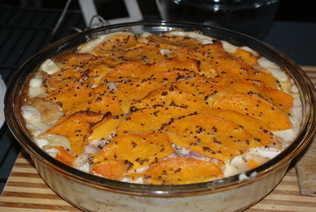
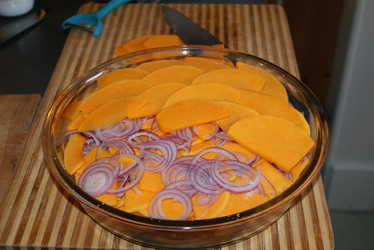


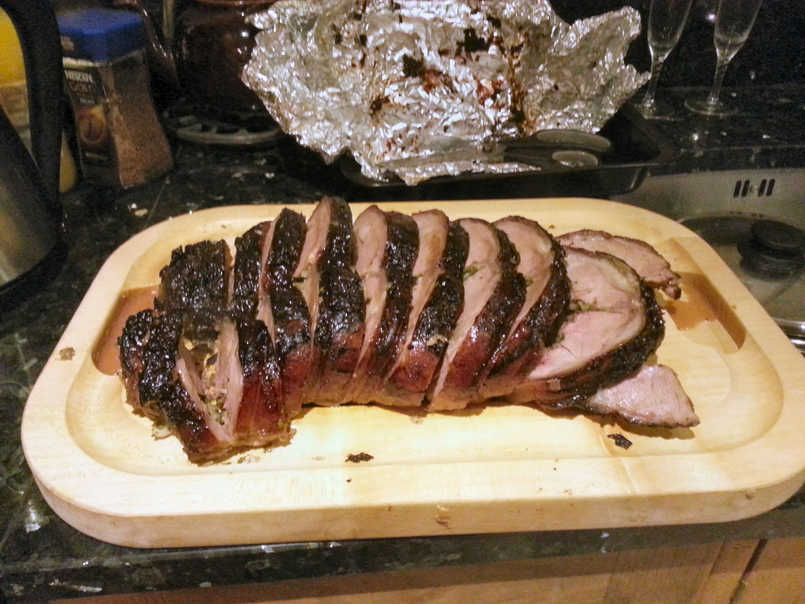
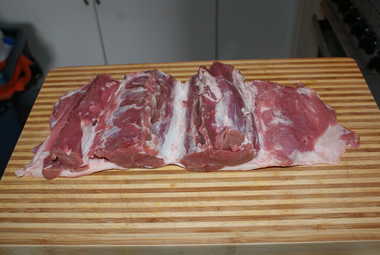
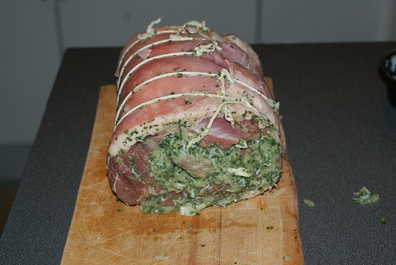
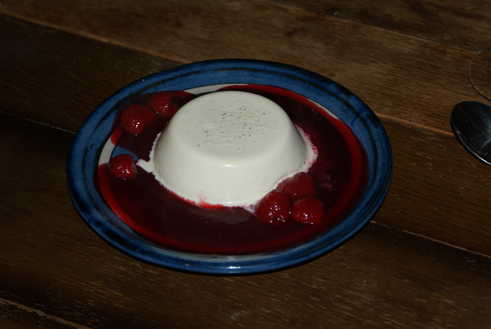
Plus if you leave the thin pear slices in too much lemon juice for too long (a couple of hours or so) they do begin to disintegrate.